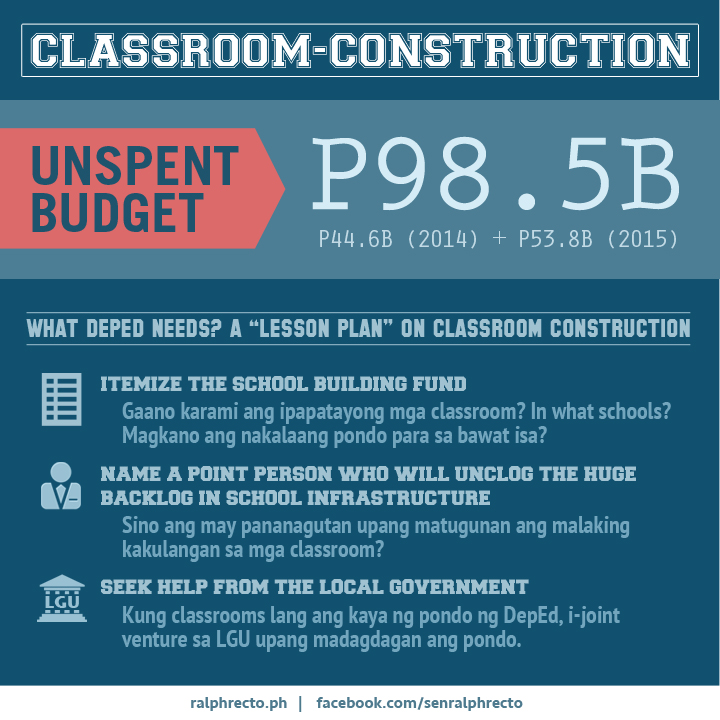Recto seeks Palace action on EDSA-like pace classroom construction
One way to solve the “EDSA-like” pace in building classrooms is to list down in the national budget the names of the schools where they will be built, Senate President Pro-Tempore Ralph G. Recto proposed today.
Recto made the proposal after the Department of Education (DepEd) admitted before a House hearing last Tuesday that P98.5 billion – P44.6 billion for 2014 and P53.8 billion for 2015 – in classroom-construction funds have not been spent.
“The only solution is to itemize the school-building fund. How many classrooms will be built in what schools and how much is the authorized budget for each?” Recto said.
“Unbundling the classroom budget fund will solve one of the main causes of delay, which is too much time spent in choosing, evaluating and approving school sites,” Recto added.
The senator is also urging Malacañang to name a “point person who will unclog the huge backlog in school infrastructure.”
What DepEd needs is a “lesson plan” on classroom construction, the senator stressed.
“Sa ngayon kasi, hihingi sila ng malaking pondo, tapos hindi naman pala alam kung saan itatayo. Akala ko ba zero-based budgeting tayo, that we start from scratch and build the budget up from zero by adding the inputted needs?” Recto said.
“Pero pagdating sa classrooms, mukhang ang nangyayari ay ‘zero-based knowledge’ budgeting kasi hindi alam kung saan itatayo ang mga ito. Inuuna ang pera bago ang pangangailangan. It is putting-the-car-before-the-horse kind of budgeting,” he lamented.
Recto rallied his colleagues to demand from DepEd “the particulars” of its proposed 2016 classroom construction fund.
“The listing must be attached to the DepEd budget. If the Department of Health (DOH) can do it for their Health Facilities Enhancement Program (HFEP), why can’t DepEd do it?” Recto said.
He was referring to the DOH’s HFEP for 2016 which itemizes the 3,886 barangay health centers, 3,200 school-based health stations, and 796 hospitals to be upgraded.
For 2016, DepEd is asking P61.8 billion to build 43,000 classrooms – 20,000 for K-10 classes, and 23,000 for Senior High School or Grades 11-12.
“But here we go again: They are not telling us where these will be built. It is zero-based knowledge budgeting again. There is no enumeration, no project details,” he said.
Recto said he will also “ask the budget gatekeepers” in the Department of Budget and Management (DBM) for their basis in endorsing the request of the DepEd. “What’s the empirical basis? What was the formula used?”
Recto said he was surprised by DepEd’s admission that “even the 2014 allocation” has remained undisbursed.
“We were under the impression that of the 43,138 classrooms to be built that year, only 7,000 remained unfinished as of February 2015. ‘Yun pala, mas malala pa,” he said.
“The challenge now is to prevent the backlog from piling up. There’s this huge backlog for 2014. We have 44,663 rooms that must go up this year, and then 43,000 classrooms next year,” he said.
According to Recto, bottlenecks “must be identified and solutions put in place because at the end of the day, it is the children who suffer.”
Among the solutions Recto is proposing is for DepEd “to share its burden and seek help from local governments who are more than willing to help and put in their equity.”
“Kung classroom lang ang kaya ng pondo ng DepEd, pwedeng i-joint-venture iyan sa LGU na upang magdagdag ng pondo para sa toilet,” Recto said.
Recto said the slow pace of classroom construction contrasts with the frenetic pace of China which is building structures on the West Philippine Sea.
“If China can rapidly build airstrips on land previously underwater, then why are we having a hard time building 60-square-meter classrooms on dry land?” he asked.


